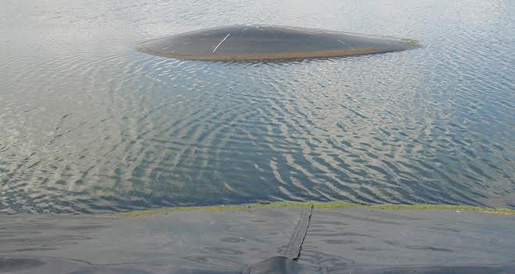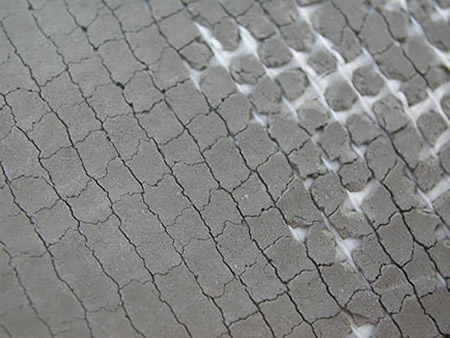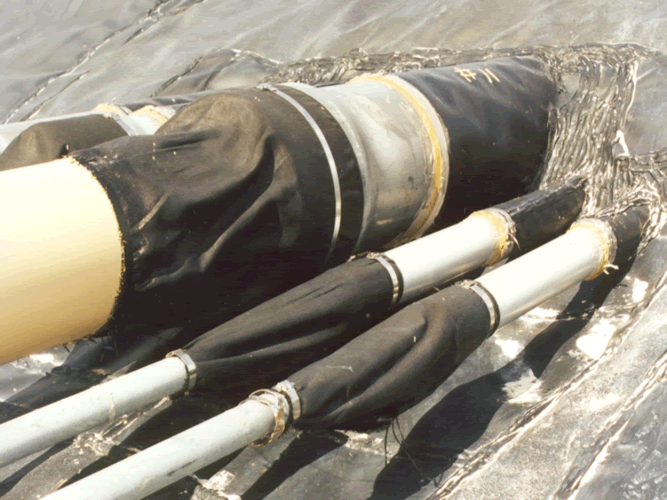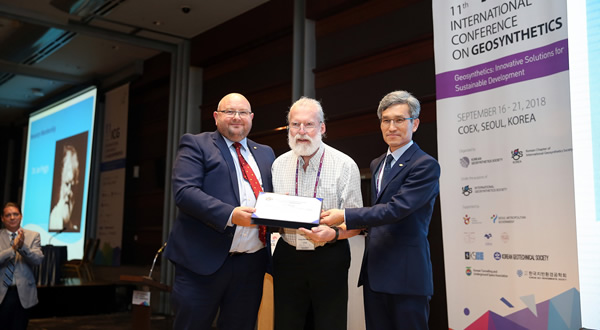After 40+ years of geosynthetic materials performance consulting work, Dr. Ian D. Peggs has made a strategic decision to close I-CORP INTERNATIONAL, Inc. for the foreseeable future and to retire. Dr. Peggs will continue his own R&D and technical support projects.
Dr. Peggs has been one of the most revered practitioners in the field of geosynthetics. Engineer Robert Wallace referred to Dr. Peggs as one of the original “Believers” – the group of engineers who were early adopters and heavy influencers in research, design, and promotion of geosynthetics. In 2018, this was certainly confirmed when the International Geosynthetics Society awarded Ian Peggs its Honorary Membership status. Only 9 practitioners have ever been granted this honor. It was one of the true high points of the 11th International Conference on Geosynthetics (Seoul).
For Geosynthetica’s editor, it was also an emotional moment (as is this announcement). Dr. Peggs founded Geosynthetica in 1999 and in 2006 invited Chris Kelsey to become part of the project.

IAN PEGGS & I-CORP
In the years since Dr. Peggs founded I-CORP, the company has served more than 300 clients around the world. This work has been heavily focused on containment projects, and it has been truly international: China, India, northern Canada, Australia, Peru, Israel, etc. Dr. Peggs notes that he has worked from 0 ft. and 14,800 ft.
RELATED: Avoiding Whales in Anaerobic Digesters (2016)
His business philosophy has been to seek novel test methods, develop them for geosynthetics, and teach others how to use them. For instance, he started work on geoelectric liner integrity and leak location methods in about 1993. By 2004, he began to partner with TRI Environmental on teaching others to perform liner integrity surveys and to certify them. The endeavor exemplifies his work: discover, improve, and turn it over to others to do the same.

Dr. Peggs has also been a long-time champion of discussing failures as one of the best ways for the field of geosynthetics to keep getting better. With I-CORP, he has led many failure investigations of whales and bottom liners of waste water plant ponds. They have served as highly instructive in conferences and publications around the world—including no shortage of primers, project notes, and guidance here on Geosynthetica.
These discussions have not always one him praise. His work on HDPE stress cracking has at times been considered disruptive, with one manufacturer calling him “a loose cannon.” It is a description Ian Peggs has relished!
A FASCINATING CAREER PATH
Ian Peggs started geosynthetic work at Hanson Materials Engineering in Edmonton, Canada about 1983 and then formed a joint venture (GeoSyntec) with Robert Wallace of EBA Engineering, also in Edmonton. Dr. Peggs moved to Florida in 1991 and was the 7th member of the Giroud/Fluet GeoServices consulting team, setting up the GeoSyntec lab and investigating liner failures—mostly stress cracking.
RELATED: A Primer for Preventing HDPE Geomembrane Whales (2018)
I-CORP followed in 1991, growing to 10 people, mostly CQA, then being reined back to two (Doug Hamilton) when Dr. Peggs was spending more time on administration work than materials performance. It has been I-CORP ever since.

In the 1990s, he published a print newsletter called Industry Insight, which in 1999 transitioned into being the world’s first digital publication on geosynthetics and affiliated geotechnical engineering: Geosynthetica. Dr. Peggs’s daughter-in-law Elizabeth ran Geosynthetica from 1999 to 2018, when she retired from the field for new industry opportunities.
Ian Peggs notes that in “retirement” he will remain involved in particular endeavors. Chiefly:
- Remote field surveys controlled from the office
- Drone-assisted CQA
- Liner/pipe illustrated failure catalog. This has been tried before but no-one has made it work.
- Student mentoring
- Industry Resources
In his letter to the industry, Dr. Peggs notes, “It has been a pleasure working with you all and your colleagues. I wish you all a successful New Year. Please keep me in the loop for all new developments so I can spread the word.”
His updated contact details are included in his letter (PDF). Geosynthetica encourages you to contact Dr. Peggs.












